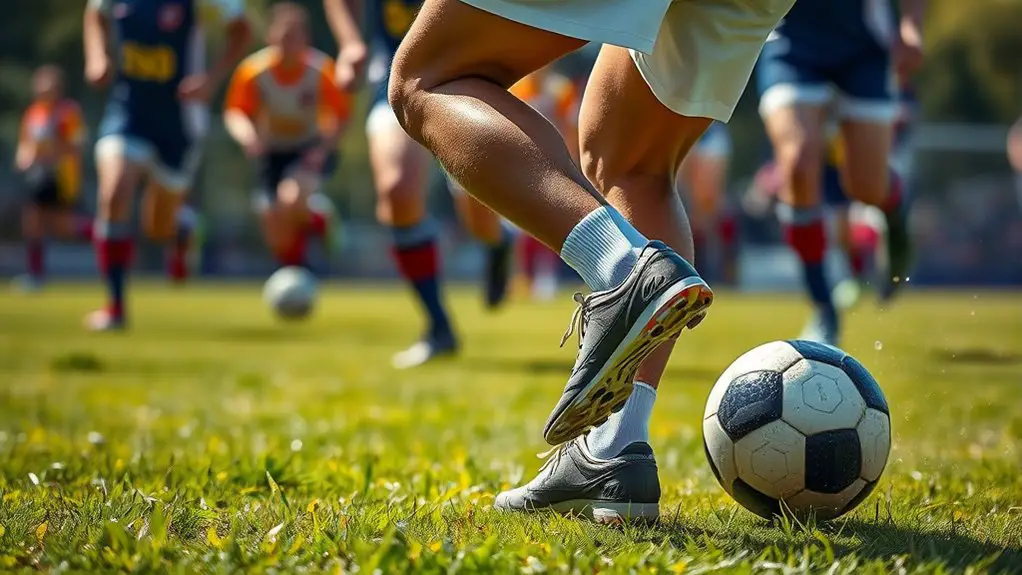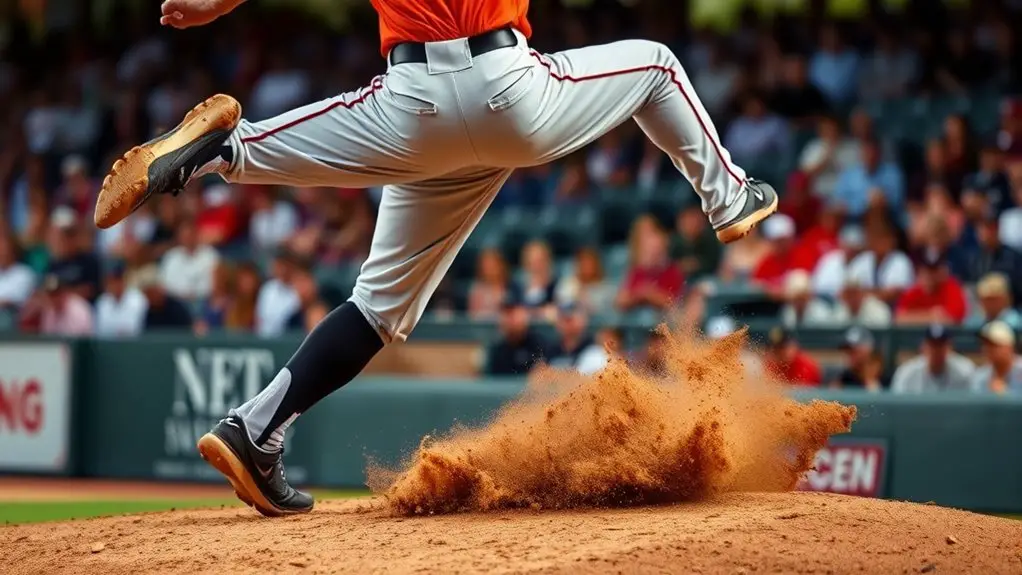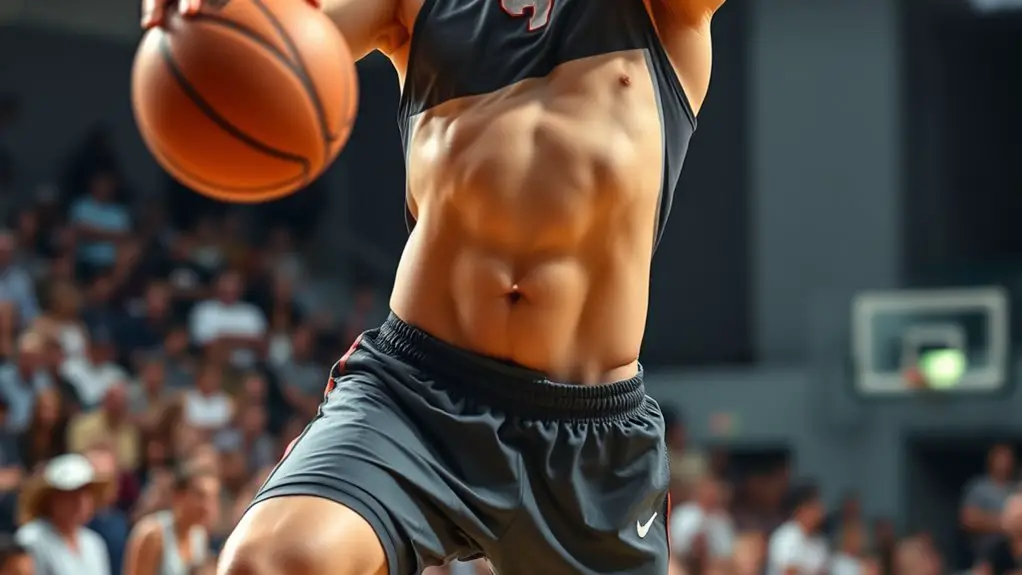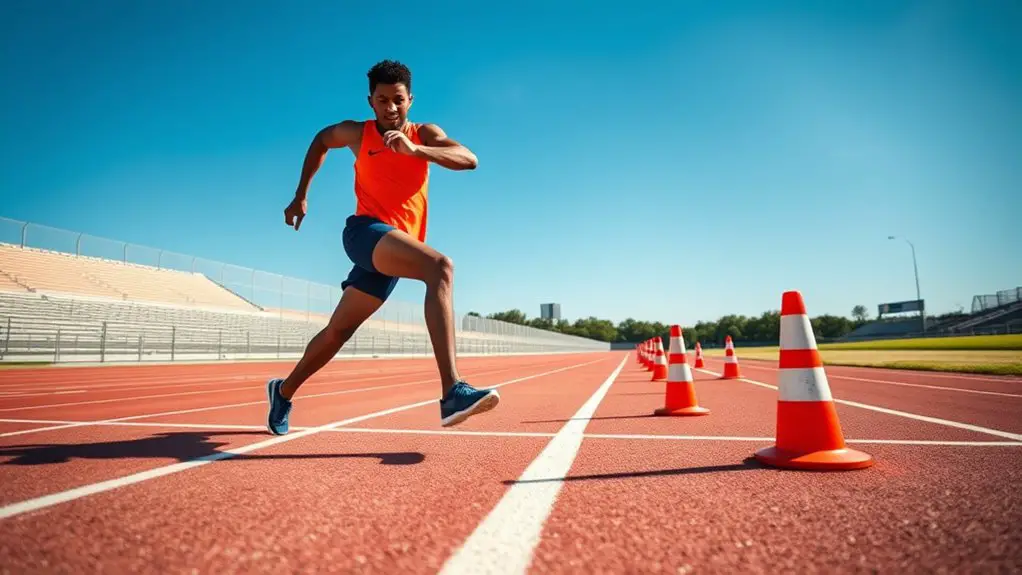The biomechanics of turning and cutting in sports is key to enhancing your performance and preventing injuries. Proper body mechanics, joint stability, and effective weight shifts improve agility during rapid direction changes. Understanding the forces at play and the impact of footwear can boost your confidence in movement. Engaging in targeted training strategies and drills will refine your technique. Stick around, and you'll discover more insights on improving your agility and overall athletic prowess.
Understanding the Mechanics of Turning
When you're making a turn in sports, understanding the mechanics behind it is vital for performance and injury prevention. Your body mechanics play an important role in how effectively you can pivot and change direction. When you initiate a turn, think about shifting your weight smoothly onto your pivot foot. This not only helps you maintain balance but also allows for a quicker, more responsive maneuver.
Mastering pivot techniques involves engaging your core and using your arms for momentum. As you turn, visualize your body as a coiled spring ready to release energy. Keep your knees slightly bent to absorb forces and protect your joints. Additionally, practicing balance training can significantly enhance your ability to make sharp turns while minimizing the risk of injury. Remember, every sport has its unique demands, so adjusting your turning style can enhance your freedom of movement. Embrace the flow of the game, and let your understanding of these mechanics guide you to perform with agility and confidence.
The Role of Joint Stability in Cutting Movements
When you're making sharp cuts on the field, joint stability plays a vital role in how well you perform. It not only enhances your agility but also helps prevent injuries that can sideline you. Understanding this connection is key to improving your game and staying healthy. Enhanced proprioception contributes to your ability to maintain joint stability during sudden movements.
Importance of Joint Stability
Joint stability is essential for athletes executing cutting movements effectively and safely. When you engage in cutting, your joints must maintain proper alignment to support quick changes in direction. This stability allows you to absorb forces and transfer energy efficiently, enhancing your performance. By focusing on stability training, you can strengthen the muscles around your joints, improving their ability to resist unwanted movement. This means you'll feel more confident when making those sharp turns and sudden stops, giving you the freedom to play your best. Remember, good joint alignment and stability aren't just about power; they're vital for control and precision, helping you navigate the field or court with agility and grace.
Impact on Injury Prevention
Although cutting movements are essential for performance in many sports, they also pose a significant risk of injury if proper joint stability isn't maintained. When you make those sharp turns, your joints endure stress that can lead to serious injury mechanisms, like ACL tears or ankle sprains. Ensuring joint stability allows you to execute these movements safely, giving you the freedom to play your best without fear. Incorporating specific rehabilitation techniques—like strength training and balance exercises—can enhance that stability. By focusing on joint integrity and recognizing how your body moves, you reduce the risk of injury, keeping you in the game. Remember, a stable joint is key to maintaining your athletic freedom and performance.
Forces Involved in Quick Direction Changes
As athletes make quick direction changes, the forces generated by their bodies play an essential role in maintaining balance and control. When you pivot or cut, you're manipulating force vectors to create a dynamic response that helps you stay on your feet. Your body generates angular momentum, which is vital for changing direction rapidly. This momentum allows you to harness the energy from your movements, enabling smooth shifts without losing speed.
The ground reaction forces beneath your feet provide the necessary grip, working in tandem with the forces your muscles exert. These interactions guarantee that every twist and turn feels fluid and natural. By understanding how these forces interact, you can improve your agility and performance in any sport. Agility training techniques empower you to move freely, enhancing not just your skill but also your enjoyment of the game. So, next time you cut, feel the forces at play and own your movement!
Analyzing the Impact of Footwear and Surface
The forces generated during quick direction changes are greatly influenced by the footwear you wear and the surface you're on. Your choice of footwear design can make a significant difference in how effectively you can cut and turn. Shoes with proper surface traction help you grip the ground, allowing for explosive movements and reducing the risk of slipping. If you're running on turf, for example, you'll want cleats that enhance your grip, whereas indoor surfaces may require a different sole type for ideal performance.
Moreover, it's essential to reflect on how the surface interacts with your footwear. A smooth surface might not provide enough traction for aggressive cuts, while a textured surface can give you the freedom to move confidently. Choosing the right type of cleats is crucial in optimizing your performance and ensuring you maximize your potential on the field. So, when you lace up, think about how your footwear and the surface beneath you can elevate your game and release your potential.
Injury Risks Associated With Poor Cutting Technique
When you cut or change direction quickly, improper technique can lead to serious injuries. Your body's mechanics play a vital role in how well you perform and how safe you stay. If you're not using the right form, you risk straining muscles, tearing ligaments, or injuring joints. These injuries can sideline you, limiting your freedom to play the sports you love.
To enhance injury prevention, it is important to undergo regular technique assessments. This helps you identify flaws in your cutting movements and adjust them before they result in harm. By being proactive and focusing on your biomechanics, you can maintain your agility while minimizing the risk of injury. Remember, the better your technique, the more confident and free you'll feel on the field or court. Embrace the responsibility of refining your skills, and you'll enjoy the thrill of sport without the burden of injury. Additionally, incorporating proper warm-ups and stretching into your routine can significantly decrease the likelihood of injuries.
Training Strategies for Improving Turning and Cutting
To enhance your turning and cutting skills, incorporating specific training strategies is essential. First, agility drills should be a key component of your workouts. These drills help improve your footwork, coordination, and reaction time, allowing for sharper turns and quicker cuts. Think about ladder drills, cone sprints, or shuttle runs to develop that explosive movement.
Next, strength training can't be overlooked. Focus on exercises that target your legs, core, and hips, as these muscle groups play a vital role in maintaining balance and power during turns. Squats, lunges, and deadlifts not only build strength but also stabilize your joints, reducing injury risks.
Lastly, don't forget to practice your technique regularly. Use what you've learned from agility drills and strength training in game-like scenarios to truly refine your skills. Embrace this freedom in your training, and you'll see significant improvements in your performance on the field or court. Additionally, proper footwork is crucial as it reduces the risk of injuries while enhancing your overall performance.
Case Studies: Successful Athletes and Their Techniques
While many athletes excel in their respective sports, the techniques they use for turning and cutting can vary considerably, showcasing a range of strategies tailored to their unique skill sets. Take a moment to look at some successful athletes; their movements reflect extensive athlete analysis and a deep understanding of biomechanics.
For instance, a professional soccer player might utilize sharp, explosive cuts to evade defenders, relying on a technique breakdown that emphasizes quick foot placement and body lean. Meanwhile, a basketball player may employ a more fluid, lateral motion, combining balance with agility to navigate through tight spaces. Incorporating specific drills such as lateral bounds can further enhance these athletes' agility and responsiveness.
These athletes exemplify how personal style and technique come together, allowing them to harness their physical capabilities fully. By studying their methods, you can gain insights into optimizing your own turning and cutting techniques, opening up new avenues for performance enhancement in your chosen sport.
Frequently Asked Questions
How Do Age and Fitness Level Affect Turning and Cutting Abilities?
Did you know that nearly 30% of people over 65 experience a significant age-related decline in agility? As you age, your turning and cutting abilities can diminish, impacting your overall movement. However, maintaining a good fitness level can lead to positive fitness adaptations, helping you retain those skills longer. Embracing regular exercise allows you to enjoy freedom of movement, keeping you active and engaged in life's adventures, regardless of age.
What Role Does Mental Focus Play in Executing Turns and Cuts?
When you're executing turns and cuts, mental focus is essential. It's not just about physical skills; it's also about how well you can visualize your movements using mental imagery. Concentration techniques can help you stay in the moment, allowing you to react swiftly and confidently. By honing your focus, you can enhance your performance, making those sharp turns and quick cuts feel more natural and freeing, ultimately elevating your game.
Can Turning Techniques Vary Between Different Sports?
When it comes to turning techniques, you might say there's more than one way to skin a cat! In soccer, sharp turns help evade defenders, while basketball cuts focus on quick direction changes to lose opponents. Tennis pivots allow you to chase balls effectively, and in rugby, sprints require explosive turns for maximum speed. Figure skating edges give you that graceful glide, highlighting how each sport tailors techniques to its unique demands.
How Does Nutrition Influence Performance in Turning and Cutting?
Nutrition plays an essential role in your performance, especially when it comes to turning and cutting. By focusing on nutritional timing, you can fuel your body effectively before and after your workouts. Don't forget about hydration strategies, too; staying properly hydrated guarantees your muscles function efficiently. When you combine these aspects, you're setting yourself up for success, allowing for greater agility and precision during those quick movements on the field or court.
What Equipment Is Essential for Optimizing Turning and Cutting Performance?
Imagine feeling the ground beneath you as you pivot effortlessly, your movements fluid and controlled. To optimize that performance, you need the right gear. Footwear design plays an essential role, providing support and grip for sharp turns. Training aids, like agility cones or resistance bands, can enhance your skills, pushing you to new limits. With the right tools, you'll embrace the freedom to move dynamically and confidently, mastering every twist and cut.




